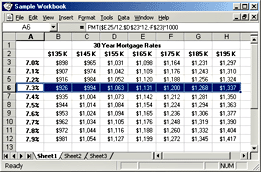
Design Specifications and Guidelines - Window Management
A workbook is a design for managing a set of views that uses the metaphor of a book or notebook. Within the workbook, you present views of objects as sections within the workbook's primary window rather than in individual child windows. For more nformation about child windows, see "Mutiple-Document Interface" later in this chapter. Figure 10.1 illustrates one possible way of presenting a workbook.
Figure 10.1 A sample workbook design (click to enlarge image)
For a workbook, you can use tabs to serve as a navigational interface to move between different sections. Locate the tabs to fit the content and organization of the information you present. Each section represents a view of data, which could be an individual document. Unlike a folder or workspace, a workbook may be better suited for ordered content — that is, where the order of the sections is significant. In addition, you can include a special section listing the contents of the workbook, like a table of contents. This view can also be included as part of the navigational interface for the workbook.
You can use COM to support transfer operations so the user can move, copy, and link objects in the workbook. You may also want to provide an Insert command that allows the user to create new objects and include a new section tab in the workbook. You can also include a Save All command to save any uncommitted changes or to prompt the user to save or discard those changes. When the user closes the workbook, follow the normal conventions for handling unsaved edits or unapplied transactions.
A workbook helps save screen real estate by enabling your application to share interface elements across views, including the menu bar and status bar. A workbook also provides quick user navigation to multiple views, but it is not the right choice if you need to provide simultaneous views.
Fundamentals of Designing User Interaction
Design Specifications and Guidelines